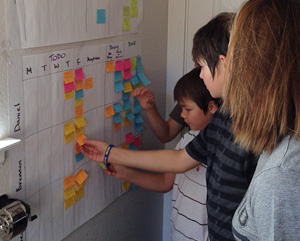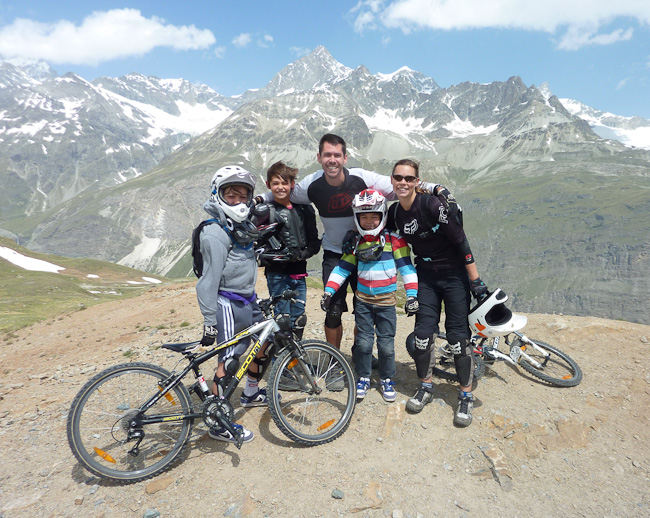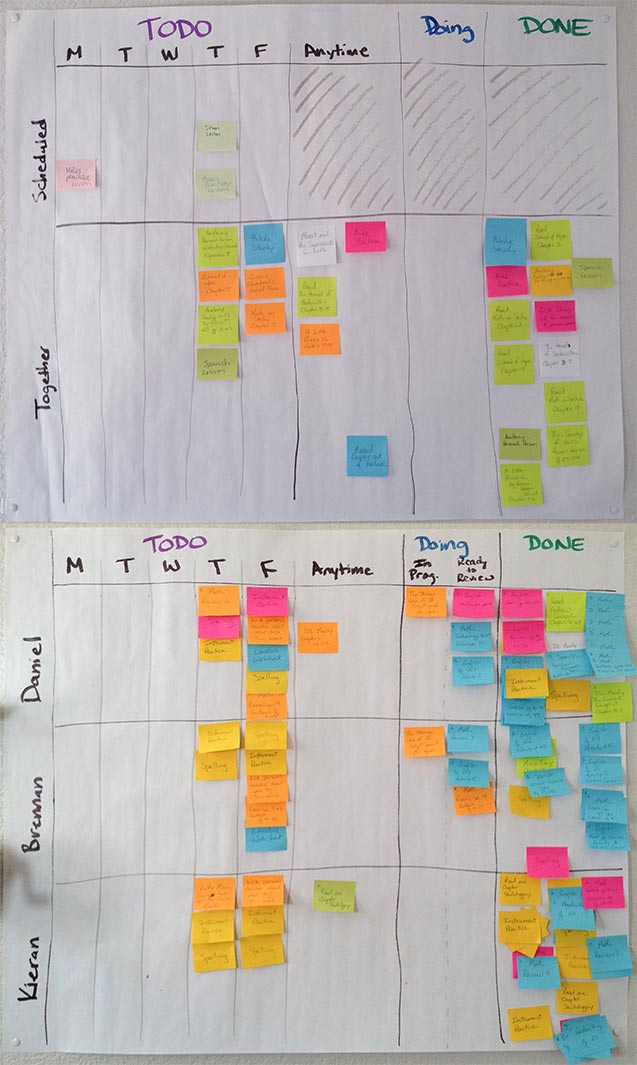Agile Homeschool
 My wife and I have been homeschooling our 3 boys since our oldest, who turns 13 tomorrow, started kindergarten. From the beginning, we’ve tried to apply the Agile, Lean, and accelerated learning principles I use in my work. After 8 years of experimentation, we’ve settled on a system that works really well for our family.
My wife and I have been homeschooling our 3 boys since our oldest, who turns 13 tomorrow, started kindergarten. From the beginning, we’ve tried to apply the Agile, Lean, and accelerated learning principles I use in my work. After 8 years of experimentation, we’ve settled on a system that works really well for our family.
This post isn’t about why we homeschool, what curricula we use, etc. Rather, I’d like to give a glimpse into how we apply some of the principles and practices I use and teach in my classes to a non-software context.

Our school has some natural cadences built in. We spend our summers mountain biking, so the school year naturally runs Fall through Spring. Our core curriculum divides each year into four units, which fit pretty well around holidays and major bike races. Standardized testing happens right before we break for the summer. And with weekends off, there’s a natural weekly cadence through the whole year. Within the week, there’s specific work to do each day. We organize our schoolwork to follow these patterns, planning for years, quarters, weeks, and days at different levels of detail.
Each week, usually on Friday afternoon but sometimes as late as Sunday evening, we reflect on the past week and plan the next. We look at our calendar and learning goals for the upcoming week and fill the queues on our board with the assignments and activities the boys will need to complete.

We assume that the boys want to learn and can self-organize to have the kind of day they want to have. So we’ve set up each week and day as a pull system. We identify and prioritize what needs to be done, indicating constraints as appropriate, and they pull assignments when and how they choose. Some days this requires more encouragement. Other days, my wife and I wake up to find that they’ve completed most of their work so they can spend the afternoon on their bikes.
Here’s a snapshot of the board yesterday morning:

As you can see, it’s more complex than the typical 3-state Scrum story board. We still have Not Started, In Progress, and Done states. But the Not Started state in particular is more nuanced. Some items need to be done on a particular day (e.g. daily musical instrument practice). Other items can be done anytime during the week (e.g. “read chapters X through Y from book Z”). Some items can be done by one child independently (e.g. a math worksheet). Other items need to be done with someone else, a brother or parent or everyone together (e.g. a spelling test or science experiment). Some items can go straight to Done. Most items require a review first. We’ve experimented with a variety of ways to visualize this before finally settling on this board design, which has been stable for almost a year.
(It’s not noted on the board, but we have a policy limiting WIP to 1 item at a time per child. They’re not allowed to multitask.)

Sometimes when I tell people about our approach, they ask questions like, “How do you get the kids to pull their own work?” We’ve mostly found that we don’t have to “get them do it.” Well-designed learning is inherently rewarding. We’re deliberate about the curricula and assignments we choose; if one isn’t working, we change it. We assume the boys are able and motivated to choose how to approach their work, and most of the time, they live up to those expectations.
I tell my agile classes that motivation is often the canary in the coal mine for systemic issues. You may see a change in your own or your team’s motivation before you can name the thing in the system you should keep or change. We see the same pattern in education. When, for example, we observed that our older boys were consistently unmotivated to pull math tasks, rather than pushing them to do those tasks, we had a conversation with them to find out why math wasn’t working. We ended up switching to another curriculum that was more challenging and better-designed. Now, they’re pulling math first most days and even asking for more math assignments.
Of course, we value responding to change over following a plan. This week was going to be a normal school week, but then an opportunity came up to visit Mount Rushmore on Monday and Tuesday, so we reorganized the week to build learning experiences around the trip, and off they went.
Next month is Agile For All’s first alumni conference. We called the conference Humanizing Work because we believe the values and principles that make agile organizations successful are rooted in how we function as humans. Agile approaches conform work to people instead of trying change people to fit work. So, it’s not surprising that the same principles work for our kids’ education. It all comes back to treating people as people.
UPDATE 10/29/14: Check out the latest on how we’re doing Agile Homeschool here: Agile Homeschool Update.





Nice example of using agile outside the work place !! And it is successful. Thanks for the nice article.
Thanks for the comment, Srinath. I’m glad you enjoyed the post.
Very interesting post. I like that people use Agile outside of software. And by the way I hop you enjoy biking in Switzerland!
Thanks for the comment, David. We had a great time in Switzerland. That photo was from Zermatt, which was quite lovely. I look forward to going back someday.
I love how you can apply the concepts of Agile to this. I also love how you can inspect and review and then adapt to incremental improvements such as in the case with Math. One of the things that you did to find out why Math wasn’t working was ask “Why” and then finding out what “motivates” your kids to do Math. The Why and what Motivates are true in any complex adaptive system.
Plus you get mucho points for being on a bike — my other love
Thanks for a great article. We homeschool as well, and my wife and I regularly discuss how to make the ‘logistics’ of the day work. With 5 children, it’s not that easy and often feels like a juggling act (for her particularly). Foolishly, I’d never connected the dots from the Agile approach I advocate at work to how to apply those concepts at home … Love it!
PS. I’ve looked a bit closer, and I suspect that you’ve colour coded the board? I’d love to hear your thoughts behind the different categories. Also, what have you used the scheduled lane for? It seems to be setup a little differently.
Regards
Derek
Most of the time, we use color to differentiate between items the boys can call done on their own (e.g. music practice) vs items that need review to be called done (e.g. a math exercise). When that picture was taken, we were running out of PostIts in the right colors, so I’m pretty sure color doesn’t mean anything. This week, it’s back to normal.
The scheduled lane is where we capture calendar items like music and bike lessons. We use it to remind us to plan less work on certain days.
I came across your blog recently and had one of those “aha moments”. I really, really like it. I never thought of splitting the columns in the days of the week. We have a “weekly Agile chore chart” that we use only for the chores that need to be done around the house. It’s a monthly white board calendar with five chores listed under the Sunday column and then everyone picks the days and the chores that they will complete by putting their name under that day/chore. It works great. My oldest one is five and he is so good at it. I put together an Agile board just for him to start practicing to remember to empty his backpack, to read a book, pack lunchbox, etc all in the preparation for next years homework. So, we modified the board by splitting it into days of the week as you have it and he likes that. I think the traditional way just did not click and work for him. I do however have couple of questions for you:
1. How do you stand up meetings with your children? Especially, how your young ones participate?
2. Who writes the Post it notes tasks? Either for household work or homework or practice/study?
3. How do you show them how to work on the project? For example, build a rocket ship out of cardboard? My son likes to use recycling materials to build things, but sometimes wants to do it right away. How would you teach a kindergarten how to work on the project while using Agile board?
Again, Thank you for sharing how your family uses Agile board.
Regards,
Mateja
It’s not as structured as a typical Daily Scrum. Everyone just says what they intend to do that day. There’s some discussion of how to move things around if there are calendar items or fun things someone wants to add. Our youngest is almost 10, so everyone is able to participate.
My wife writes most of the PostIts on Friday, when she plans the next week. We don’t track housework on the board, just school. Most chores happen on a schedule and rotation—the 3 boys take turns unloading the dishwasher, feeding the dog, etc. The board isn’t really designed for this kind of structure.
We use different color PostIts to indicate whether the child can do the task or their own or whether they need a parent to help. The nature of the help depends on the activity. In kindergarten, most activities required some instruction or guidance from me or my wife. By junior high, most activities are self-directed, using the instructions in the textbook, for example.
Thank you. I appreciate you taking the time to reply.
Richard, thank you for the transparency into your own life processes, it’s fascinating. As someone who thinks about education systems a lot, and spurred by your caption mentioning “command and control,” I wonder if you can speak a little more on how you might see Agile fitting into traditional K-12 education, or even higher ed? Looking at the four Agile Manifesto values, can easily rewrite #1 and #4 for education, but less so #2 and #3. I’d just generally love to learn more of your thoughts on this if and as you are ready to share them or point me to other similar resources. Many thanks!
Good example to implement Agile in our daily lives.
This is a great article. I was also homeschooled and feel that I would have been more productive and motivated if there was a system like this used.
As I am now getting ready to start my own family, thoughts about what I want my child to learn has been in my mind.
I want to homeschool but do not want to fall into the same learning mistakes as my parents.
Thank you for sharing and motivating!